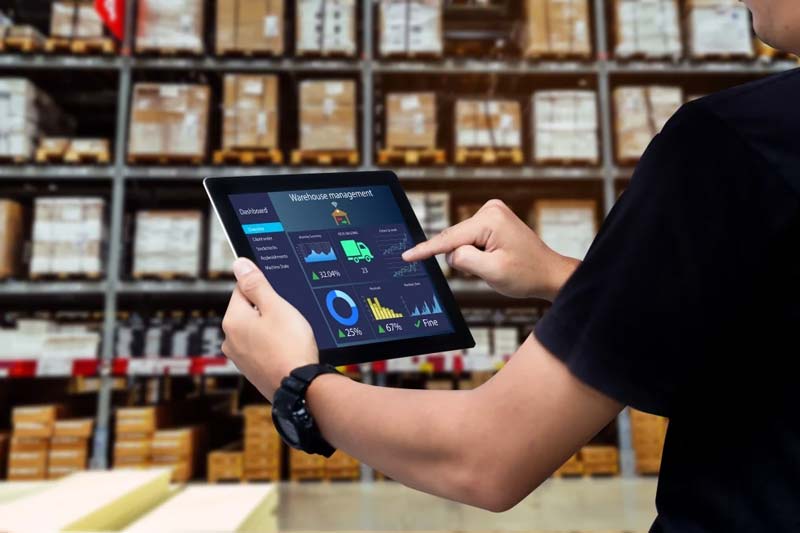Most people think the products on supermarket shelves feature barcodes to make checking out quicker and easier, but these black and white strips of data do far more than that. They are connected to software that monitors stock levels and reorders items automatically when supplies run low, which improves efficiency, prevents empty shelves and reduces waste.
Automated inventory tracking was pioneered in industries like food and fashion where time is of the essence. Food that is not sold quickly spoils and has to be thrown away, and clothing that is no longer in style has to be deeply discounted or sold at reduced prices to companies that specialize in distressed merchandise.
Harness the Power of Warehouse Management Systems for Your Apparel and Fashion Brand
Warehouse management systems were not always a crucial part of the supply chain. There was a time when companies stocked vast amounts of inventory to make sure that adequate supplies would always be on hand. But all of that changed in the 1970s when the founder of Toyota missed a train.
The train arrived on time, but Kiichiro Toyoda still missed his appointment, which made him realize that timing is everything in commerce and in life. This epiphany led to the development of what has become known as the Just-in-Time manufacturing model, and this has become the way the world does business.
Largely used in auto manufacturing, the JIT system is based on having just enough supplies on hand to meet current orders, and it only works when companies are highly efficient. Warehouse organization and management is at the heart of this approach, which is why software that automates tasks like receiving, packing and shipping is so important. Here are a few reasons why this is especially true in the fashion industry:
- Style trends: Fashion changes quickly. Few young men were interested in tailored suits in the early 1960s but finding these garments in retail stores became almost impossible after the Beatles wore them on the “Ed Sullivan Show.” Fashion companies that want to react quickly to developing trends need highly organized warehouses and supply chains, which is where warehouse management system software comes in.
- Seasonality: Fashion is a seasonal business, which means clothing must be shipped to stores or made available online at just the right time. Effective warehouse management removes the guesswork and makes this much easier.
- Unpredictability: Garments that are expected to sell well do not always resonate with consumers, and items that were added as an afterthought to fill out a line sometimes become hot commodities. WMS software helps fashion companies to spot these trends early and capitalize on the opportunities they create.
What Is WMS Software?
Warehouse Management Software, or WMS for short, is a type of application that monitors inventory levels, tracks shipments and streamlines the way orders are picked and packed. Keeping track of inventory is done with either barcodes or radio frequency identification tags, which saves time and eliminates human error.
When WMS software is integrated with Enterprise Resource Planning (ERP) solutions, online shopping carts and supply chain management technology—manufacturers, retailers and even customers can get all of the information they want and need virtually instantaneously. If you want to use WMS software to reap the benefits of an automated and integrated supply chain, the features that you should look for include:
- Robust warehouse design: The way warehouses are laid out can greatly influence their efficiency. WMS software should monitor shipments and orders to ensure that items selling quickly are placed close to dispatch points or are grouped and organized in other efficient ways. Warehouse management and maximizing storage space is particularly important in industries like fashion that experience seasonal surges in demand.
- Receiving and storage: WMS software should keep track of where every item in inventory is located at all times to make sure that their pickers can always find the products they are looking for quickly.
- Inventory tracking: Barcodes or RFID tags allow WMS software to monitor deliveries, shipments and inventory levels automatically. This information should then be made available to decision-makers in real-time.
- Shipping: WMS software should be able to produce forms, labels and any other documents needed to process shipments automatically.
- Reporting: In addition to providing accurate details about inventory and orders, WMS software should be able to identify potential shortages and bottlenecks and issue alerts so steps can be taken to avoid them.

The Great Thing About ERP Integration
WMS software works best when it is integrated with an ERP solution that handles other aspects of inventory and order management like invoicing and accounting. When orders are placed, ERP software transmits the information to the warehouse where WMS uses it to see that customers get their goods as quickly and efficiently as possible.
When supplies run low or products are not selling in the numbers anticipated, the WMS should inform ERP software so that supplies can be adjusted accordingly. That is why it is always wise to choose WMS and ERP inventory management software that works together and has been designed for specific industry applications.

N41 Brings Fashion into the Information Age
The team at N41 has been helping fashion companies to grow their brands for more than a decade. We are dedicated to helping our clients harness the potential of the information age by offering them versatile and scalable ERP solutions that are designed to integrate with Warehouse Management Solutions and other specific needs of our clients. If you would like to learn more about the ways N41 could take your business to the next level, you can use our online form to schedule a free demonstration.
